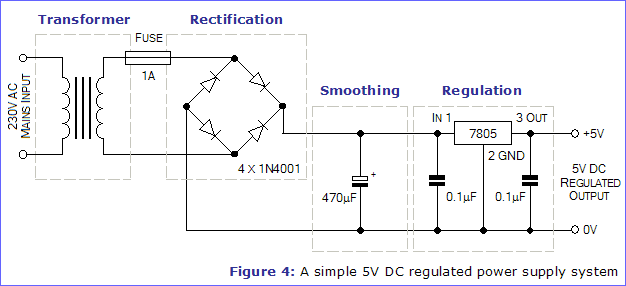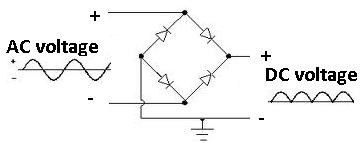78xx power supply
A super-simple power-supply design for low-voltage DC
Introduction
Every electronics project runs on a power-source of some kind. Unless you're messing with batteries (and even then) there's a good chance you'll require a power-regulation circuit like the one presented below:
This design is based around 4 main parts. A transformer (optional in case of DC-input voltage) a bridge rectifier , a smoothing capacitor and the LM78XX chip which contains a 'linear voltage regulator'. This article will explain what they all do, how it works (kinda), how to design and build one and will present some considerations concerning the use of these devices. The design is split up in a part that concerns itself with transforming AC into DC and a part that explains just how to regulate the DC part with the LM78xx chip. For this reason, the design will also be of interest if you are simply looking to transform a DC voltage into a lower voltage to fit your circuit.
The problem
Let's say we have a little circuit that we would like to make but it requires 5volt DC power. Unless we can find some pre-made power-supply somewhere, we might have to build our own little power-supply circuit too. Even if we are not faced with the task of going from AC-voltage to DC-voltage ourselves, we might still need to regulate the voltage to get it to be the required 5Vdc instead of, say, 12Vdc that we get from a lead-battery.
In the rest of the article we're going to assume to assume that we want a 5Volt powersupply like the one presented in the figure above. We're going to see how we could build it all from scratch, right down from going to 5Vdc from a wall-socket with 240Vac. Also, we're going to show what part can be left out if you already have 12Vdc (from a lead battery, for example).
Getting from AC to DC
As you might know , electric power is available in both AC and DC flavors. The distinction between the two is that with DC, the 'voltage' or 'potential' between the two poles of the supply is at a steady level.
Let's say, 5Vdc. Looking at it with an oscilloscope would reveal a single straight line with nothing interesting happening. With AC power, the potential between the two poles oscillates between two extremes at a fixed frequency;normally 50 or 60Hz, depending on where you live. The reason for this is explained further in AC , but it's sufficient to realize that it is easier to transform high AC voltages into lower AC voltages than it is to transform high DC voltages into low DC voltages (go ask Nikola Tesla why this is).
For that reason, if you're given an AC-voltage, you will need some way of turning it into lower AC voltage first, and then turning it into a DC voltage. This is where the AC transformer and bridge rectifier come in. Please consider the circuit presented earlier.
The transformer there is a device which uses two copper-wire coils wound around a single metal frame to create a electro-magnetic way of transferring power from one coil to the other. The ratio between the windings on first coil and the second coil determine what voltage comes out of the 'secondary coil' when you put some potential (say, 240Vac) on the 'primary coil'. See the line transformer article for more info about the theory on this.
A fuse is positioned in between the transformer and the next part, the rectifier, to burn through when too much current has been drawn from the circuit; protecting the parts of the power-supply against overload. Essentially it's just a thin wire that will burn through if too much current runs through it; it doesnt do anything to the voltage or the waveform that comes from the transformer.The frequency and waveform of the AC-voltage coming out of the secondary side of the transformer will be the same as that of the primary side; except at a different voltage. That voltage , however, still needs to be turned into something resembling DC before we can hope to use it for most DC-based electronics.
For this purpose we require the bridge rectifier . This is a simple circuit made out of four diodes (in this case of a popular type, the 1n4007) configured in such a way (see diagram) that it will basically 'flip' the negative parts of the AC waveform (see diagram above) and put them on the positive side of the graph. This works because diodes only conduct in one direction and like a broken connection when the polarity is reversed. This results in a fluctuating/oscillating potential between the two outputs of the bridge rectifier circuit that has one pin always be 'positive' in respect to the other output terminal. See the diagram on how this looks. Note that the bridge rectifier can also be bought as a single component with four pins sticking out of it, containing the correct configuration of four diodes inside of it, internally.
After we've achieved the task of making one terminal be positive with respect to the other terminal, we can now take on the task of smoothing away the oscilation. As it is, using this voltage as it is would make parts like logic-gates severely unhappy; not to mention add an incredible buzzing sound to anything that has a speaker connected to it.
How to do this is covered in the next section.

